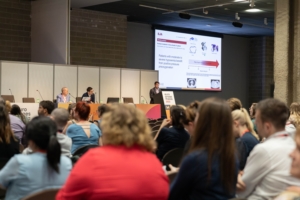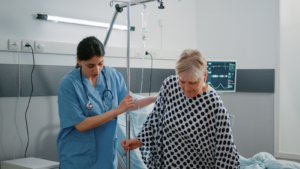Congress Newsletter 2022
Friday-night admission of a severely hypoxic patient
Session 09CB1 – took place on Sunday 5 June 1400-1500H in Space 1
This session can be watched on-demand on the Euoranaesthesia platform.
This case-based discussion session took place during Sunday Afternoon’s programme and looked at the different courses of action that could be after Friday-night admission of a severely hypoxic patient.
Let me try non-invasive ventilation

He discussed how the use of Noninvasive ventilation (NIV) in patients with acute hypoxemic respiratory failure has been studied for nearly 25 years, but it is still a controversial topic. The main aim of its use in this patient’s population is to avoid intubation and invasive mechanical ventilation.
“NIV may be able to reduce work of breathing and improve oxygenation. On the other hand, the use of NIV in patients with high respiratory drive may lead to patient-ventilator asynchronies and generation of high tidal volumes,” said Prof Cortegiani. “Potential consequences are high transpulmonary pressure and worsening of lung injury (so called ‘patients self-induced lung injury’). The choice of NIV interface can also make a difference in terms of efficacy and safety since data suggest that the use of a helmet may be associated with reduced intubation rate.”
In this talk, he discussed the potential benefits and risks and modalities of NIV in severe acute hypoxemic patients.
Let me proceed with intubation
This strategy was discussed by Dr Vincenzo Russotto, Assistant Professor, Department of Anesthesia and Intensive Care. University Hospital San Luigi Gonzaga, University of Turin, Italy.
He described how tracheal intubation and invasive mechanical ventilation are necessary in patients failing an NIV attempt and in most severe cases of respiratory failure.
Although a life-saving procedure, tracheal intubation is associated with a high incidence of adverse events in critically ill patients. Indeed, in a large international prospective cohort (INTUBE study), major peri-intubation adverse events were reported in 45% of critically ill patients, with haemodynamic collapse as leading event, registered in 43% of cases, followed by severe hypoxemia in 9% of cases and cardiac arrest in 3% of cases. Peri-intubation adverse events are associated with increased ICU and 28-day mortality.
“Until now, most research efforts focused on methods of pre-oxygenation, with positive pressure ventilation suggested for patients with moderate to severe hypoxemia,” explains Dr Russotto. “On the other hand, the snapshot of real life, coming from the INTUBE study, identified peri-intubation haemodynamic optimisation as a high priority for care of critically ill patients. Recently, the use of propofol has been identified as the single modifiable intervention associated with an increased risk of peri-intubation cardiovascular collapse. Given the availability of alternative agents with a more favourable hemodynamic profile (such as ketamine and etomidate), its use may be avoided for intubation of critically ill patients.”
References
Russotto V, Myatra SN, Laffey JG et al. Intubation Practices and Adverse Peri-intubation Events in Critically Ill Patients From 29 Countries. JAMA 2021 Mar 23;325(12):1164-1172.
doi: 10.1001/jama.2021.1727.
Russotto V, Tassistro E, Myatra SN et al. Peri-intubation Cardiovascular Collapse in Critically Ill Patients: Insights from the INTUBE Study. J Respir Crit Care Med 2022 May 10. doi: 10.1164/rccm.202111-2575OC.
Let me select the best invasive ventilation approach
This strategy was discussed by Dr Michela Rauseo, Dept of Medical Surgical Science, University of Foggia and Anesthesia and Intensive Care Unit at the University Hospital “Policlinico Riuniti di Foggia”, Italy.
She explained how tidal volume and positive end-expiratory pressure may have a key role in the treatment and outcome of severely hypoxic patients. The variety of acute respiratory distress syndrome phenotypes implies the personalization of those settings. To guide personalised tidal volume and positive end-expiratory pressure, physicians need to have an in-depth understanding of the physiologic effects and bedside methods to measure the extent of these effects.
“Tidal volume induces alveolar recruitment and improves gas exchange. After setting personalised positive end-expiratory pressure, tidal volume could be based on lung inflation (collapsed lung size) respecting safety thresholds of static and dynamic lung stress. Positive end-expiratory pressure is aimed at stabilizing alveolar recruitment, thus reducing the risk of volutrauma and atelectrauma,” said Dr Rauseo. “Bedside assessment of the potential for lung recruitment is a preliminary step to recognise patients who benefit from higher positive end-expiratory pressure levels. In patients with higher potential for lung recruitment, positive end-expiratory pressure could be selected by physiology-based methods balancing recruitment and overdistension.”
She concluded that tidal volume and positive end-expiratory pressure could be kept stable for some hours in order to allow early recognition of changes in the clinical course of acute respiratory distress syndrome but also frequently reassessed to avoid crossing of safety thresholds. She said: “The setting of personalised tidal volume and positive end-expiratory pressure based on sound physiologic bedside measures may represent an effective strategy for treating severely hypoxic patients.”
Read More of our special newsletter covering our congress.










